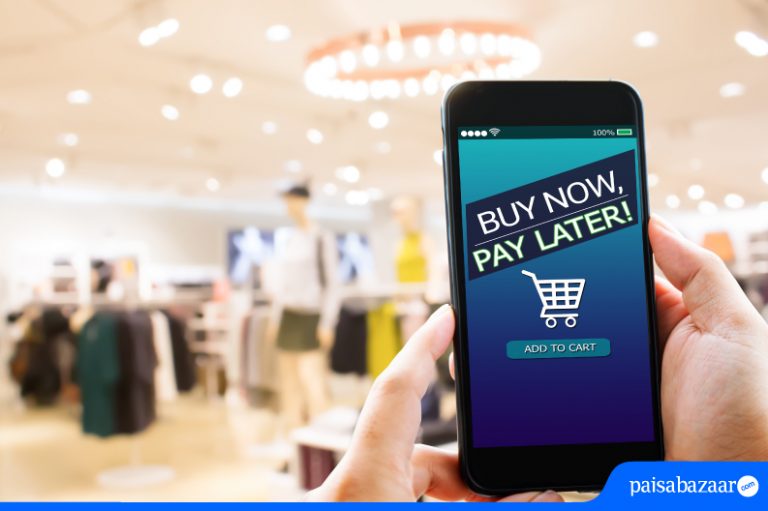

Has it ever happened to you that you wish to buy something but you neither have a credit card nor can you afford to pay for it upfront? In such a situation, the Buy Now Pay Later (BNPL) finance option comes in handy. This scheme lets you purchase without paying anything upfront and allows you to make the payments later in one shot or in the form of Equated Monthly Installments (EMIs). Read on to understand the BNPL concept in detail.
What is BNPL?
Buy Now, Pay Later is a short-term financing solution that allows customers to make purchases and pay for them later. To avail BNPL facility, the customers must sign up with BNPL providers and authorize them to make payments on their behalf. While signing up, a first-time BNPL user must complete KYC procedures on the provider’s platform. After the account has been activated, each user will be assigned a credit limit that he/she can use to make purchases. In case of late payment, a penalty may also be levied on the user.
Let us understand the working of BNPL with the help of an example:
Suppose, you opt for a BNPL facility and you have been allotted a credit limit of Rs. 25,000 and you wish to buy a product worth Rs. 20,000. You can simply use the BNPL limit to make the purchase. While making the purchase the entire amount will be deducted from the available credit limit and you will not have to pay anything from your pocket. However, once the lender (BNPL Provider) has paid on your behalf, you are liable to repay the amount within a stipulated time. Now you have the option of repaying the amount in the form of EMIs or as a lump sum payment. The biggest advantage here is that the BNPL payments come with a very low or zero interest rate.
How is the BNPL credit limit decided?
As of now, there is no set criterion to decide the BNPL limit, however, different providers use different algorithms to analyze the spending pattern of the user and offer a limit thereafter. The credit limit offered under BNPL may also vary from provider to provider – for instance, Flipkart offers a seamless checkout process for up to Rs 10,000, under their BNPL services while ZestMoney and other BNPL lenders offer up to a personalized limit of Rs 60,000 to their users.
What are the benefits of BNPL?
- BNPL allows the customers to buy products with even a small sum of money
- Customers with no credit score can build a good credit history despite not having a credit card
- Making regular payments will help you create a positive credit history if your BNPL provider reports your account activity to the credit agencies
- BNPL facility can also be utilized by people who are otherwise not eligible for credit cards
- A lower interest rate is levied on the user for late payments, as compared to credit cards
- Offers a very smooth user experience
BNPL is also beneficial for the merchants as the BNPL providers pay commission to them. In addition, the merchant is instantly paid, and the BNPL provider takes care of all the associated risks, such as liability for fraud, chargebacks, etc.
What is the future of BNPL in India?
The BNPL market in India is thriving and this rise can simply be attributed to several factors such as low credit card usage in the country, inclination towards digital payments, rapid increase in the number of fintech companies ready to disrupt the traditional methods of accessing credit, etc. Because of the simplicity and easy access to credit, BNPL has become one of the most popular products among GenZ customers, young millennials, and first-time credit borrowers, who otherwise are frequently neglected by traditional banks.
According to The Covid Era of Rising Fintech, a report published by RazorPay, the Indian BNPL market would witness a rise by more than 637% in 2021, up from 569% in 2020. According to the Indian consultancy Redseer, the BNPL market would expand in India from USD3-3.5 billion now to USD45-50 billion by 2026.
In India, there are several BNPL players, including LazyPay, ZestMoney, Paytm Postpaid, MobiKwik, Flipkart Pay Later, Amazon Pay Later, and Capital Float. Traditional banks are also joining the BNPL bandwagon. This includes ICICI PayLater from ICICI Bank and FlexiPay from HDFC Bank. Axis Bank also acquired Freecharge from the e-commerce company Snapdeal.
Risks associated with BNPL
Even though BNPL offers numerous benefits to its users, it surely has a downside too. Mentioned below are some of the risks associated with BNPL:
- Missing payments may turn into debt and end up hampering consumer’s credit report
- BNPL’s seamless checkout experience can lead to impulsive buyers who end up overspending
- Millennials and Generation Z may end up developing unhealthy financial habits
- Since there are no strict rules and regulations associated with BNPL, every provider may charge differently for late payments
Bottom Line
Given the current stats and prevalence, BNPL seems to be a promising option for Indians who are new to credit and looking forward to building a good credit history. BNPL is also gaining popularity because of its ease of use and flexibility in payment options. However, it is still a form of loan that the consumer must eventually return. Customers must comprehend the consequences of failing to return the money on time in order to prevent interest and a loss in credit score.